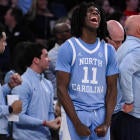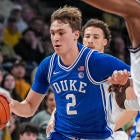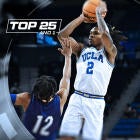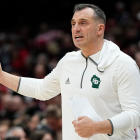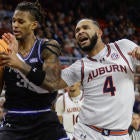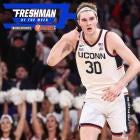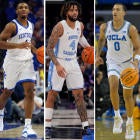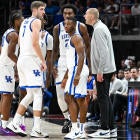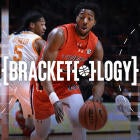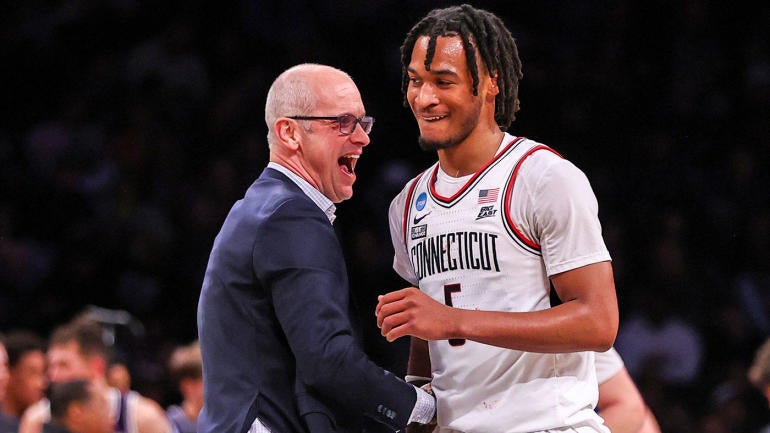
College basketball just had the best offensive season in the history of the sport. Yeah, you read that right.
The 17.1% turnover rate was the lowest since KenPom started tracking it in 1997. Teams shot a combined 50.3% on two-pointers. That's the best mark since data started being tracked in 1948. It was also the best free throw shooting season in college basketball history.
Even with rosters changing at a higher rate than ever, there's reason to believe the arrow is only pointing up. The skill is improving at the lower ranks. Shooting is of utmost importance, and the processes for plenty of teams are elite.
Basketball X's and O's are a copycat sport. Teams steal concepts from everybody and anybody. Everyone is on the hunt for the next big thing that it can use to put opposing defenses in a bind. The sport has changed and will continue to evolve as offenses rapidly put up historic numbers.
There are terrific offensive coaches everywhere. Hofstra's Speedy Claxton is an exceptional X's and O's mind. Princeton's Mitch Henderson uses isolation brilliantly. New Michigan coach Dusty May has found ways to use space so creatively. Illinois' Brad Underwood has been the architect of three top-10 offenses in the past eight years using three vastly different techniques. No one scored more points off handoffs last year than Nebraska under Fred Hoiberg.
Let's dive into 10 of the top offensive masterminds in the country and what makes 'em so successful.
Buckle up.
(No particular order.)
Nate Oats, Alabama
Here's where Alabama has finished in Shot Quality's Rim & 3 rate since Nate Oats took the gig.
- 2020: 3rd nationally
- 2021: 1st nationally
- 2022: 1st nationally
- 2023: 2nd nationally
- 2024: 5th nationally
Alabama takes and makes a ton of 3-pointers, as was well documented by CBS Sports' Matt Norlander and Kyle Boone in a popular piece back in 2021.
How it generates those treys directly results from Alabama's non-stop pressure on the rim. The most efficient shot in basketball will always be a bucket at the rim. Alabama averaged 35 points per game at the rim last season, per Synergy. That ranked sixth-best nationally.
Alabama's transition offense is deadly, but in the halfcourt, Alabama is connected, intricate and diverse. Alabama used handoffs a ton (11th-most in the sport) to create advantages and put defenses in a bind. Alabama's offense was also elite after timeouts and on out-of-bounds plays.
It helps to find great players who can execute this scheme.
As a sophomore at Ohio, Mark Sears made 80 jumpers. That's a pretty darn good number. Fifty of 'em came off the dribble, both from the midrange and from 3-point range. He was capable but inefficient. Sears shot just 25% on his 83 off-the-dribble jumpers. Sears could create the space but he couldn't finish the play.
Oats saw a jewel in disguise.
Alabama has almost completely eliminated that shot from his in-game repertoire. In the last two years, Sears has taken just 24 off-the-dribble, two-point jumpers combined.
The jitterbug lefty is still allowed to take those off-the-dribble jumpers that he's so clearly capable of making, but Alabama doesn't let him coast into those pull-up 2s. If there's time left on the shot clock, Sears will scurry back behind the line for 3-pointers. Sears drilled 35% of his 74 off-the-dribble treys last season. He's improved his game and his shot chart to become one of college basketball's best guards.
That's the Alabama way.
Greg McDermott, Creighton
Liberty was the only team in college basketball last year that attempted more unguarded catch-and-shoot 3-pointers per game than Creighton.
McDermott seemingly always finds a way to get four shooters on the floor, and he knows how to get them open. No team made more 3-pointers off screens than Creighton last year. Creighton's top-of-the-key flair screens are so simple but so effective. Ryan Kalkbrenner set road-grating screens to free up Baylor Scheierman and Steven Ashworth to cash in. Oh, and Creighton is elite around the rim too. Creighton has rated in the 90th percentile or higher nationally in efficiency at the rim in three of the past four seasons
Dan Hurley, UConn
Dan Hurley, with a big assist from key assistant Luke Murray, has become the talk of the town in the X's and O's community. UConn has run phenomenal actions on its way to back-to-back national championships.
UConn's offense is so layered with concepts stacked one on top of the next. If you can't think, you can't play for Hurley. His teams play smart, connected basketball on the offensive end, and UConn's ability to generate elite looks with two non-shooters on the floor together was masterful.
The level of misdirection UConn uses with pindowns and flares is unmatched. So much action and false action to set up what they’re ultimately looking for. pic.twitter.com/HvJ2T1gTUj
— Eric Fawcett (@EricFawcett_) February 16, 2024
All the fluff, pomp and circumstance about Hurley's sets might cover up just how special UConn's transition offense is.
Let's compare UConn to Iowa. Iowa ranked 19th in adjusted tempo, per KenPom. UConn was all the way down at 330th nationally in pace. It's a stark difference. The Hawkeyes have been one of the most potent transition offenses for years.
Very few run like Fran McCaffery's bunch. No high-major team played in transition more often than Iowa last season, and the Hawkeyes were highly efficient, averaging 1.21 points per possession.
And yet, Iowa had one game against a high-major team (Seton Hall) with 25+ points in transition.
UConn had four explosions of 25+ points in transition against high-major teams. It averaged the exact same points per possession (1.21) in transition as Iowa.
Part of Hurley's brilliance is his ability to blend a quick-strike transition offense that capitalizes at an Iowa-like level on turnovers or iffy shot selection by an opponent with a plodding, intricate halfcourt offense that has counters to the counters and waits for one mistake to pounce.
UConn was already a handful in the halfcourt, but its transition offense is the secret sauce that produced killshot after killshot.
Mark Pope, Kentucky
New Kentucky coach Mark Pope is a bit of a mad scientist. The former BYU coach knew he had to be different to survive in the Big 12, so Pope unleashed an offense that shot 50.4% of its attempts from beyond the arc.
It was just the third time in the KenPom era that a high-major team attempted more 3s than 2s, joining 2017-18 Washington State and 2018-19 Villanova. Having something in common with Jay Wright is a pretty good thing.
Pope found something by inverting the floor with big man Aly Khalifa who could step out and drill a 3-pointer, but most importantly, pass the rock. Kentucky should be able to emulate that a little bit with a passing big man like Amari Williams and a horde of shooters, headlined by Jaxson Robinson and Koby Brea.
Kentucky hopes Pope is its version of Oats at Alabama. Oats is a champion of the "Rim & 3" rate, something that John Calipari did not embrace during his tenure.
Kentucky's Rim & 3 rate, per Shot Quality
2023-24: 79%, 227th nationally
2022-23: 70%, 356th nationally
2021-22: 65%, 352nd nationally
2020-21: 67%, 329th nationally
2019-20: 67%, 342nd nationally
Compare that to where Pope finished in Rim & 3 rate, per Shot Quality.
2023-24: 87%, 43rd nationally
2022-23: 83%, 98th nationally
2021-22: 73%, 291st nationally
2020-21: 75%, 223rd nationally
2019-20: 77%, 203rd nationally
As you can see, Pope didn't also fully embrace that "Rim or 3" philosophy until the last few years. Part of that was personnel. Part of that could also be a hint of changing his style.
Change is also coming to Lexington because things are about to look vastly different.
Josh Schertz, Saint Louis
"Process > outcome" sounds good in theory, but it's hard when things aren't working. Josh Schertz's first Indiana State team had a great process. Over 88% of Indiana State's shots came either from 3-point range or at the rim. It ranked top 10 nationally in Shot Quality's Rim & 3 rate, but it turned the basketball over more than any other team in Missouri Valley play and it couldn't shoot. Indiana State shot just 32% from 3-point range.
The process was right. The results were an 11-win team and the 264th-best offense in America.
That won't do the trick.
Two years later, nothing about Indiana State's offensive process drastically changed. The personnel got better. The development was there. And now the outcomes were so much better. Indiana State finished No. 1 in Shot Quality's Rim & 3 rate the last two seasons. Indiana State took and made a ton of 3-pointers the last two seasons, but it combined that with the No. 1 two-point offense in the country in back-to-back years.
This offense made Schertz one of the coveted names in the coaching carousel. He earned a huge raise to go to Saint Louis, and he isn't coming alone. Star big man Robbie Avila and sniper Isaiah Swope are on the way, too.
My favorite part of Indiana State’s offense is how screeners are as dangerous as the player receiving the screen. After back screens, flares, and pin downs, screeners are always looking to slip to the rim or zoom to the ball for a handoff. pic.twitter.com/qnknSG7cmL
— Eric Fawcett (@EricFawcett_) January 9, 2024
Bill Self, Kansas
Self, long respected as one of the elite offensive masterminds, has not lost his step. Kansas has been elite after timeouts for years. It's scored on more than 40% of its possessions out of timeouts for nine straight years under Self. That's a bonkers number.
Even with the worst-shooting Kansas team in his 21-year tenure, Self's X's and O's chops shined. Kansas ranked fifth nationally, averaging 12 points per game off cuts. Kansas' swath of backdoors has been around forever, and yet, Self still manages to befuddle even the best defenses.
Niko Medved, Colorado State
Niko Medved knows how to design offenses to create the easiest, most efficient shot in basketball: a bucket at the rim. Colorado State has shot over 72% at the rim in back-to-back seasons, per CBB Analytics. That ranks in the 100th percentile nationally in both seasons.
Medved's Princeton-style offense relies on high-processing, high-energy guys who can pass, cut, shoot and dribble. Colorado State is one of the offenses that isn't solely reliant on 3s or layups. The Rams haven't been near the top of the leaderboards in Rim & 3 rate next to Indiana State or Alabama. Instead, the Rams cut like crazy. Colorado State ranked sixth nationally, averaging 11.5 points per game off cuts. It's easy to cut hard when there are willing passers all over the floor. Colorado State was one of the most unselfish teams in college basketball last season. The Rams assisted on 64.9% of their buckets last year. That ranked second in the nation, just behind Kansas.
Colorado State’s princeton offense has been absolutely beautiful to watch. Niko Medved has the Rams scoring as efficiently as anyone in the country right now. pic.twitter.com/loRhsLqb69
— Eric Fawcett (@EricFawcett_) November 16, 2023
Mark Few, Gonzaga
It's hard to find a more consistent pick-and-roll offense in college basketball than Gonzaga. Mark Few has this thing humming. In 14 of the last 16 years, Gonzaga rates in the 90th percentile or higher in pick-and-roll efficiency, per Synergy.
The names and faces on the roster change. The clinic remains.
Gonzaga's pick-and-roll offense was almost unstoppable in its Round of 32 demolition of Kansas. Gonzaga averaged 1.32 points per possession in the 89-68 victory. Bill Self changed coverages and mixed personnel to no avail.
Synergy tracked Gonzaga scoring 42 points on 31 pick-and-roll possessions against KU. Thorough destruction.
Look at how the KU coaching staff reacts during some of these clips.
Matt Painter, Purdue
Matt Painter can go onto the recruiting trail armed with data that Purdue will throw the ball to its bigs more than any team in America.
Purdue has finished in the top-10 in post-up usage in nine of the past 10 seasons, per Synergy.
- 2023-24: No. 1 nationally
- 2022-23: No. 1 nationally
- 2021-22: No. 2 nationally
- 2020-21: No. 1 nationally
- 2019-20: No. 10 nationally
- 2018-19: No. 173 nationally
- 2017-18: No. 7 nationally
- 2016-17: No. 1 nationally
- 2015-16: No. 1 nationally
- 2014-15: No. 2 nationally
But Purdue is so much more than just post-ups. Painter is one of the most creative coaches at designing open catch-and-shoot 3-pointers for his snipers. Purdue shot an unconscious 50.9% on its 3-pointers off screens last year, per Synergy. That ranked No. 4 nationally and No. 1 amongst all high-majors.
It helps when you can get looks like this.
Purdue is known for running a ton of sets, but this one might just be my favorite. So many actions that are essentially all decoy to set up a three for one of the best shooters in the country
— Joe Jackson (@joejacksonCBB) March 25, 2024
My best guess at naming it would be
Iverson Elbow Zoom Floppy Twirl Stagger pic.twitter.com/XJ37N2hBPN
Scott Drew, Baylor
A decade ago, Scott Drew used post-ups early and often to build some of college basketball's best offenses.
It's fascinating how Drew has almost wholly abandoned that strategy in the last six years.
Baylor's post-up usage, per Synergy.
- 2023-24: 3.5%
- 2022-23: 0.8%
- 2021-22: 1.4%
- 2020-21: 1.6%
- 2019-20: 3.4%
- 2018-19: 3.7%
- 2017-18: 12.4%
- 2016-17: 12.5%
- 2015-16: 11.8%
- 2014-15: 10.7%
That pivot has helped Baylor's offenses flip from really good to excellent. Landing NBA-caliber guards in the portal and on the recruiting trail is a big piece of that, but Drew's fingertips are all over an offense that's putting up historic numbers.
No team made more 3-pointers off baseline out-of-bounds (BLOBs) plays than Baylor (34) last season. 15 of the 34 came from the corners.
It's not a coincidence.
Baylor's shot profile is filled with corner 3-pointers. Shooting variance is supposed to be a thing, but it isn't at Baylor on corner treys. A down year at Baylor is right around 35% which is the national average for corner 3-pointers. But in three of the last five seasons, Baylor has shot over 40% on corner 3s.
Baylor's efficiency on corner 3-pointers, per CBB Analytics.
- 2023-24: 40%
- 2022-23: 41%
- 2021-22: 35%
- 2020-21: 48.7%
- 2019-20: 35%
It's hard to see Baylor going back to a post-up-heavy diet anytime soon. That certainly won't be the case in 2024-25 with Jeremy Roach, VJ Edgecombe, Langston Love and Jayden Nunn headlining a phenomenal backcourt.
But the corner 3s aren't going anywhere.
MORE COLLEGE BASKETBALL COVERAGE: 10 players who made right call returning to college, including UConn's Alex Karaban









